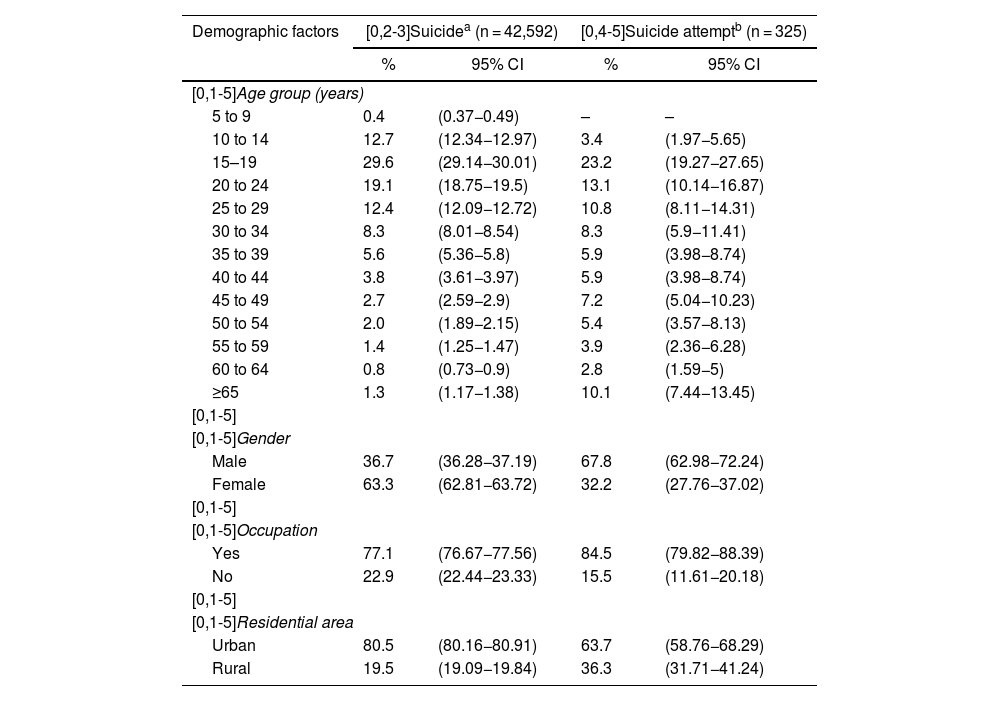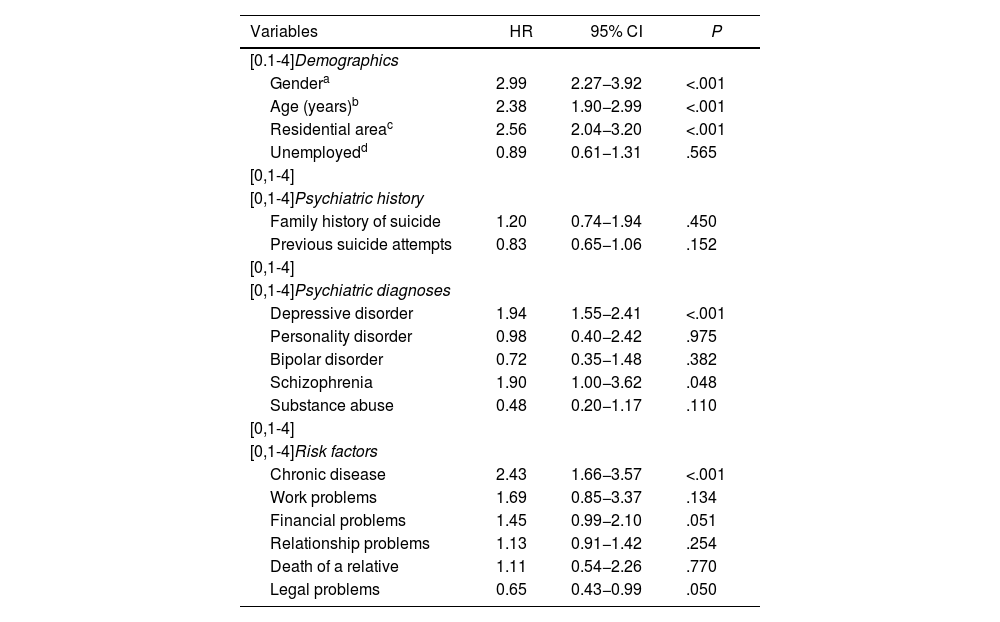Suicidal behaviour is the cause of half of all violent deaths. It is considered to be a public health problem with one million victims a year. Suicide attempt is the most important risk factor. In Colombia, in 2017 the suicide attempt rate was 51.8/100,000 inhabitants, and the fatality rate reached 10.0/100,000. The objective is to identify suicide attempt factors associated with death and determine survival after the attempt for 2 years.
Material and methodsRetrospective cohort study and survival analysis. A total of 42,594 records of the suicide attempt surveillance system databases and 325 records of death by suicide in 2016 and 2017 were analysed. The risk factors were examined and a χ2-test and multivariate analysis and logistic regression were performed. Cumulative survival probability was calculated using the Kaplan-Meier method. A Cox regression model was applied to determine the proportional relationship of the suicide attempt variables that are related to suicide.
ResultsMen die by suicide 4.5 times more often than women. One in four suicide victims had made at least one prior suicide attempt. The attempt factors related with death by suicide were: male gender (HR = 2.99; 95% CI, 2.27−3.92), adulthood (over 29 years, HR = 2.38; 95% CI, 1.90−2.99), living in a rural area (HR = 2.56; 95% CI, 2.04−3.20), chronic disease history (HR = 2.43; 95% CI, 1.66−3.57) and depression disorder (HR = 1.94; 95% CI, 1.55−2.41). Some 50% of suicide deaths occur up to 560 days after the suicide attempt.
ConclusionsThe risk of suicide is highest in male patients, with a history of depression, chronic illness and exposure to heavy workloads.
La conducta suicida es la causa de la mitad de las muertes violentas. Se considera un problema de salud pública con un millón de víctimas al año. El intento de suicidio es el factor de riesgo más importante. En Colombia, en 2017 la tasa de intento de suicidio fue de 51,8/100.000 hab. y la letalidad alcanzó 10,0/100.000. El objetivo es identificar factores del intento suicida asociados con la muerte y determinar la supervivencia después del intento durante 2 años.
Material y métodosEstudio de cohorte retrospectiva y análisis de supervivencia. Se cruzaron 42.594 registros del sistema de vigilancia de intento de suicidio con 325 muertes por suicidio del registro único de defunciones de 2016 y 2017. Se examinaron factores de riesgo, y se realizó la prueba de la χ2, análisis multivariado y regresión logística. Se calculó la probabilidad de supervivencia acumulada con el método de Kaplan-Meier. Se aplicó un modelo de regresión de Cox para determinar la relación proporcional de las variables del intento suicida que se relacionan con suicidio.
ResultadosPor cada muerte de mujer por suicidio, mueren 4,5 varones por esta causa; 1 de cada 4 personas fallecidas reportó al menos un intento previo. Los factores del intento relacionados con la muerte por suicidio fueron: ser varón (HR = 2,99; IC95%, 2,27–3,92), la edad adulta (>29 años, HR = 2,38; IC95%, 1,90–2,99), vivir en área rural (HR = 2,56; IC95%, 2,04–3,20) y padecer enfermedad crónica (HR = 2,43; IC95%, 1,66–3,57) o trastorno depresivo (HR = 1,94; IC95%, 1,55–2,41). El 50% de las muertes por suicidio ocurren hasta en los 560 días posteriores al intento.
ConclusionesSe evidencia mayor riesgo de suicidio en pacientes varones, con historia de depresión, antecedentes de enfermedades crónicas y exposición a carga laboral.











